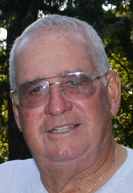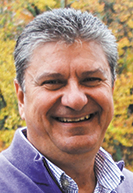Subscriber Benefit
As a subscriber you can listen to articles at work, in the car, or while you work out. Subscribe NowLongtime media professional and avid golfer Adam Grubb lumps golf content—whether traditional or in digital formats—into two categories.
“We noticed most golf content is either PGA-related and instruction or hot girls in golf carts,” Grubb said.
The 41-year-old Hoosier native suspected there was a sizable national golfing audience that wanted something different.
So Grubb launched Stick and Hack in May 2019.
He calls Stick and Hack “the world’s greatest golf club without the course.”
The startup produces a website, podcast, daily email and a cartoon called “Hack Mulligan,” which Grubb hopes to syndicate. The company also sells branded apparel and offers memberships, complete with perks.
“We target working people with families, ages 35 to 58. We appeal to people who think golf is important, but it’s not their life,” said Grubb, Stick and Hack’s CEO.
Like the increasingly popular Peloton app, Stick and Hack is attempting to build an online community. But unlike Peloton, where togetherness is virtual but workouts are real, Stick and Hack offers no remote golfing.
“We realized a lot of the enjoyment that comes from golf has to do with camaraderie,” Grubb said. “Stick and Hack is meant to be educational, entertaining and humorous.”
Grubb, always quick with a joke, mused that every good story and joke starts with two guys sitting at a bar. Such is the case with Stick and Hack.
Grubb and friend Mike Ryan were sitting at a bar talking about their shared love of golf and the community of friends it builds. So the two decided to create their own golf club—without a course and with a twist.
 The name, Grubb explained, represents who he and Ryan are.
The name, Grubb explained, represents who he and Ryan are.
“Our media and content platform allows our members to share in our unique enthusiasm for the game, friendships and connection the sport brings to every one of us, regardless if we are a stick or a hack,” Grubb said.
A stick is typically a good golfer—like Ryan—who is concerned with nuances of the game, Grubb said.
A hack is someone who loves the game but might not care about its lingo and technical aspects—and probably won’t be on the PGA Tour anytime soon. Grubb said he can definitely relate to the hacks of the world.
While he played on the golf team at Oak Hill High School in Converse, Grubb said he rarely shoots a round of 18 holes in under 80 strokes. Ryan has a personal best round of 63 and has won multiple club championships.
“I know golfers and I know the generation I’m in,” Grubb said. “I know the lifestyle and people’s appetite for media and content. I know why people belong to country clubs, and we’re bringing that to them.”
Grubb’s story is as interesting as the startup he’s spearheading. After attending Ball State University for nine days at age 18, Grubb decided to ditch college to start his career in media.
He went to work as a sportswriter for the Marion Chronicle-Tribune and as a promotions director and afternoon drive-time personality for WLBC-FM 104.1 in Muncie.
“It was the best education I could have gotten in dealing with people, problems, saving your money, paying your taxes and in just being a professional in every way,” Grubb said. “I knew what I wanted to do professionally, so I needed to get busy doing it. I didn’t need school to show me how to do it. I just needed to figure it out.”
Grubb, who lives in Noblesville with his wife, Mandie, and three school-age daughters, started Adam Grubb Media—a video marketing agency—in 2015 and has worked with such clients as Hyatt hotels, Google, the city of Carmel and The Cake Bake Shop.
Using mostly self-taught skills, Grubb has done the vast majority of Stick and Hack’s production work—including website design and development and podcast production.
Capital infusion spurs growth
With an infusion of more than $400,000 in seed funding, Stick and Hack has grown its free memberships to more than 6,000. That’s up from 1,000 just 10 months ago, thanks to a 2020 digital marketing campaign. While the company has a strong footprint in Indiana, members come from across the country.
Stick and Hack has attracted an impressive list of guests to its podcast, including Garfield creator Jim Davis, well-known golf writer James Dodson, former Indiana PGA and U.S. Golf Association executive Thomas Meeks and PGA Tour champion Gary Player, who appeared on the show this month.
Grubb said he worked his network of contacts to get Player to listen to the show. And within 48 hours of listening, Player agreed to be a guest.
Grubb also has attracted a growing cadre of sponsors, including Bombas, Sunday Golf, Tosi snacks, SIC (Seriously Ice Cold) Cups, Blue Tees Golf and Sugar Golf.
In no way is Grubb taking those successes and heading for the clubhouse. He’s still swinging away—and feels he’s still on the front nine of this journey.
In March, he plans to close on a second six-figure round of seed funding, and in early 2022, he plans to close on a seven-figure round of Series A funding.
He plans to launch an app this spring, which he says will be the focal point and driver of information for the entire Stick and Hack operation. Grubb said he’s contracting outside help to develop and launch the app.
From there, he plans a golf-centric media empire that will have few—if any—equals.
Grubb’s long-term vision includes multiple audio and video podcasts, a quarterly golf magazine, a full production team, a Stick and Hack Films division, production of multiple golf documentaries and even a golf-related crime series. He also wants syndication deals for the Stick and Hack podcast and the “Hack Mulligan” cartoon—which is produced with the help of someone who worked on the “Garfield” comic strip.
Stick and Hack also has regular Zoom meetings for its members. When the pandemic clears, it plans to host live events, including an annual two-day members event, possibly as soon as this fall.
With the help of Indianapolis-based Prolific—Stick and Hack’s primary investor and the marketing and media agency behind Bleacher Report’s launch—Grubb has developed a 493-page business plan that outlines how his dream can be made real.
Ambitious projections
Stick and Hack’s revenue stream is small now and the company is not profitable, Grubb said.
But his business plan projects Stick and Hack will have 20,000 free and paid members and $600,000 in revenue by the end of this year. That is projected to grow to 250,000 members and $13.5 million by the end of 2025.
Grubb said his business model calls for 13 revenue streams, including event sponsorship, programmatic advertising and sponsorship, premium paid memberships, and merchandise sales. He’s still determining the formula for paid premium memberships.
Only 20% of Grubb’s audience is women, but he said that’s growing.
Grubb projects Stick and Hack will be profitable within four years.
“We want to be on the cover of Fast Company [magazine] with the headline, ‘The Stick and Hack effect,’ showing how the industry looks at the normal golfer,” Grubb said.
While the plan seems ambitious, Grubb said it’s well within reach.
“When you look at the golf landscape, 250,000 [members] is a small number,” he said. “I think this is completely within the realm of what’s possible with a brand like this. And I’m very confident in our revenue projections. We have a specific formula that shows what each member is worth in terms of annual revenue.”
Meeks, the former USGA executive, moved back to Indiana from New Jersey in 2004 to be closer to family. He was introduced to Stick and Hack by golf buddies.
“They asked if I’ve ever listened to the Stick and Hack podcast, and I had not heard of it,” said Meeks, 80. “I listened to it, and the next thing you know, I’m a member. I love the podcast and really enjoy the daily emails, too. I think everything they do is really well done.”
Michael Duranko, who own a wholesale coffee and tea distribution company in Sarasota, Florida, said Stick and Hack strikes the right tone.
“I get the idea of stick and hack, a good and a bad player. I’m middle of the road. I can stick it and I can hack it,” said Duranko, 56, who became a member last year. “What they’re trying to do is create a community. There are a lot of communities out there, and some are a little too serious.
“These guys have a good sense of humor, they’re having a good laugh, and that’s what attracted me more than anything,” he said. “They have interesting guests on the podcast and they have a real playfulness.”
Duranko is also a fan of Stick and Hack’s daily email and the “Hack Mulligan” cartoon. “The email, their cartoon, all their graphics and what they put on Instagram and other forms of social media is really impressive,” he said. “It’s a great production.
“The email is a really light two-minute read; they share golf history that I find interesting and provide other factoids. Their portion size is really nice—not too much, not too little,” he added.
Growing the game?
Mike David, executive director of the Indiana Golf Office and Indiana Section of the PGA, said a social destination like Stick and Hack can help cater to the changing nature of golfers—and perhaps even help grow the game.
“The traditional player is evolving,” David said. “Guys are having a couple beers and listening to music when they’re playing. The next generation of golfer is looking for a social, fun experience. The game needs to accept those players and accommodate them as best we can.”
David noted that the Indiana Golf Office is changing its approach to its app and online presence.
“We’ve tried to expand our offerings to include things like golf news, travel discounts, events at the PGA Superstore and an online store and really creating more of a community of golfers,” he said. “We’re trying to give the new age of golfers more than a USGA handicap and our tournament results. We still want to give handicaps, but we want to do a lot more because there is a growing number of golfers who are looking for more than that.”
David is uncertain of the commercial appeal of an enterprise like Stick and Hack.
“Selling sponsorships for anything has gotten much more challenging over the last 20 years,” he said.
“There’s just so much more competition for sponsorship dollars now than there used to be,” he said. “Marketers demand a demonstrated return-on-investment, so they’ll have to demonstrate that concretely.
“Still, golf-related events and offerings can bring in golf and non-golf sponsors. And as offerings like this expand, I think that will be more the case.”•
Please enable JavaScript to view this content.




